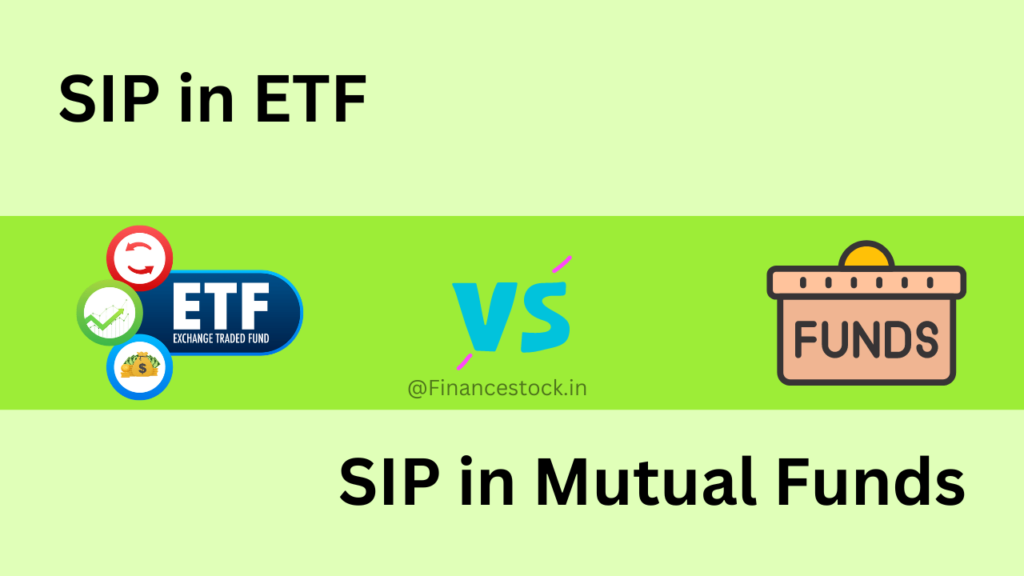Maximizing Wealth Through ETF SIP: A Beginner’s Guide
In the world of investing, building wealth over time can be a slow but rewarding process. If you’re someone who earns a consistent income every month and is looking for a systematic way to grow your wealth, then investing in ETFs (Exchange Traded Funds) through SIP (Systematic Investment Plan) might be the ideal strategy for you.

While most people are familiar with mutual fund SIPs, ETF investing offers a unique twist. This approach can potentially generate higher returns with just a few extra minutes of effort each day. In this post, we’ll explore how you can utilize SIPs with ETFs to create wealth over the long term.
What is SIP in ETFs?
Before we dive into the strategy, let’s first understand SIP. A Systematic Investment Plan (SIP) allows you to invest a fixed amount of money at regular intervals, typically monthly. Traditionally, this is done with mutual funds, where money is automatically deducted from your bank account and invested.
But here’s where the twist comes in – instead of mutual funds, we will use SIPs to invest in ETFs. ETFs are collections of stocks or bonds that are traded on the stock exchange, just like individual stocks. They are a great way to invest in broad markets, sectors, or asset classes such as gold, silver, banking stocks, etc.
The main advantage of ETFs is that they often have lower fees than mutual funds and offer you the ability to trade them throughout the day, just like stocks.
The Small Twist in ETF SIP
In mutual fund SIPs, you don’t have to monitor the market – the money is automatically invested on specific dates. But with ETF SIPs, you can get better returns by taking just 5 minutes out of your day to monitor the market. Let’s break this down:
- Set a Daily Alarm: Set an alarm for 3 PM every Monday to Friday (since the market is closed on weekends). At this time, you will quickly check the performance of your chosen ETFs.
- Track the Market Movement: The goal here is simple – check if the market is up or down for the day. Specifically, track the performance of your selected ETFs.
- Choose Your ETFs: You need to select at least 5 ETFs to monitor. These could be sector-specific ETFs like FMCG, IT, or banking ETFs, or broader market ETFs like Nifty Bees or Mid-Cap ETFs. You can also add gold and silver ETFs to diversify your portfolio.
- Invest in the Cheapest ETF: Once you have your ETFs set, the strategy is simple: invest in the one that is down the most that day. Why? Because you’re buying it at a lower price, allowing you to accumulate more units.
How to Invest: A Practical Example
Let’s assume you earn ₹50,000 per month and can invest ₹10,000 in ETFs monthly. Now, instead of investing ₹10,000 at once, you will spread this investment across the trading days of the month. For example:
- The market is open for approximately 20-21 days each month.
- So, you divide ₹10,000 by 20, meaning you will invest ₹500 each day.
At 3 PM, when your alarm rings, check which of your 5 selected ETFs is down the most that day. Suppose it’s the Mid-Cap ETF that’s down by 1%—you then invest ₹500 in that ETF for the day. The next day, you check again and invest ₹500 in whichever ETF is down the most.
By doing this, you’re practicing a form of “buying the dip,” which means you’re purchasing more units when the price is low. Over time, this strategy will allow you to accumulate ETFs at lower prices, giving you better returns when the market rises again.
Why This Strategy Works
All the ETFs mentioned above are equity-linked ETFs, meaning they are directly linked to the performance of stocks in specific sectors or asset classes. For example, when you invest in a banking ETF (like BankBees), you’re investing in a basket of top banking stocks such as HDFC Bank, ICICI Bank, and Axis Bank.
Similarly, when you invest in an FMCG ETF, your money goes into companies like Hindustan Unilever and Dabur. These are solid, established companies, so their long-term returns will usually be high.
When the market or specific sectors are down, your daily investment in these ETFs means you’re buying them at a discounted price. When the market rebounds, you’ll already have more units at lower prices, leading to higher potential gains.
Additionally, adding gold and silver ETFs helps hedge your portfolio. In case the market experiences a major correction, gold and silver prices often hold steady or even rise, balancing your portfolio’s performance.
Flexibility for Different Investors
This ETF SIP strategy is flexible enough to cater to investors with different risk appetites:
- For Aggressive Investors (Younger age group): If you’re young and can take on more risk, you might want to focus on equity-based ETFs like small-cap and mid-cap ETFs. These have higher potential for growth but come with greater risk.
- For Conservative Investors (Older age group): If you prefer lower risk, you can include more conservative options like gold, silver, or even debt ETFs in your portfolio.
Remember the 100-Age Formula, which suggests that your equity exposure should be 100 minus your age. So, if you’re 30 years old, you can invest 70% of your portfolio in equity ETFs, and if you’re 60, you might reduce that to 40%.
Benefits of This Strategy
- Higher Returns: Since you’re buying ETFs on dips, your average purchase price will likely be lower than someone who invests in a mutual fund SIP on fixed dates, regardless of market conditions.
- Cost-Effective: ETFs generally have lower management fees compared to mutual funds, which helps in boosting returns over time.
- Diversification: By choosing a variety of ETFs from different sectors and asset classes, you automatically diversify your investments, reducing overall risk.
- Simple and Time-Efficient: All you need is 5 minutes a day to check the market, making it easy to follow even for beginners.
Final Thoughts
The ETF SIP method allows you to take advantage of market fluctuations, potentially providing you with better returns than traditional mutual fund SIPs. All it requires is a little effort and discipline to monitor the market daily.
If you’re serious about building long-term wealth, this strategy could be a game-changer. Just 5 minutes a day could make all the difference between average and exceptional returns.
